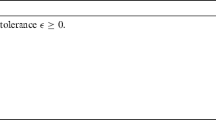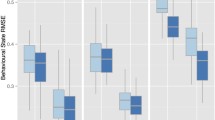Abstract
Animal movement is a complex phenomenon where individual movement patterns can be influenced by a variety of factors including the animal’s current activity, available terrain and habitat, and locations of other animals. Motivated by modeling grizzly bear movement in the Greater Yellowstone Ecosystem, this article presents an agent-based model represented in a state-space framework for collective animal movement. The novel contribution of this work is a collective animal movement model that captures interactions between animals that can trigger changes in movement patterns, such as when a dominant grizzly bear may cause another subordinate bear to temporarily leave an area. The modeling framework enables learning different movement patterns through a state-space representation with particle-MCMC methods for fully Bayesian model fitting and the prediction of future animal movement behaviors.Supplementary materials accompanying this paper appear online.







Similar content being viewed by others
References
Andrieu C, Doucet A, Holenstein R (2010) Particle Markov chain Monte Carlo methods. J Royal Stat Soc: Series B (Stat Methodol) 72(3):269–342
Ballerini M, Cabibbo N, Candelier R, Cavagna A, Cisbani E, Giardina I, Orlandi A, Parisi G, Procaccini A, Viale M et al (2008) Empirical investigation of starling flocks: a benchmark study in collective animal behaviour. Animal behav 76(1):201–215
Beaumont MA (2010) Approximate Bayesian computation in evolution and ecology. Annu Rev Ecol, Evol Syst 41:379–406
Beaumont MA, Zhang W, Balding DJ (2002) Approximate Bayesian computation in population genetics. Genetics 162(4):2025–2035
Bezanson J, Edelman A, Karpinski S, Shah VB (2017) Julia: a fresh approach to numerical computing. SIAM review 59(1):65–98
Bonnell TR, Henzi SP, Barrett L (2016) Direction matching for sparse movement data sets: determining interaction rules in social groups. Behav Ecol 28(1):193–203
Brown DG, Riolo R, Robinson DT, North M, Rand W (2005) Spatial process and data models: toward integration of agent-based models and GIS. J Geogr Syst 7(1):25–47
Christ A, Ver Hoef J, Zimmerman DL (2008) An animal movement model incorporating home range and habitat selection. Environ Ecol Stat 15(1):27–38
Couzin ID, Krause J, Franks NR, Levin SA (2005) Effective leadership and decision-making in animal groups on the move. Nature 433(7025):513–516
Couzin ID, Krause J, James R, Ruxton GD, Franks NR (2002) Collective memory and spatial sorting in animal groups. J Theor Biol 218(1):1–12
Ebinger MR, Haroldson MA, van Manen FT, Costello CM, Bjornlie DD, Thompson DJ, Gunther KA, Fortin JK, Teisberg JE, Pils SR et al (2016) Detecting grizzly bear use of ungulate carcasses using global positioning system telemetry and activity data. Oecologia 181(3):695–708
Farmer JD, Foley D (2009) The economy needs agent-based modelling. Nature 460(7256):685
Fasiolo M, Pya N, Wood SN et al (2016) A comparison of inferential methods for highly nonlinear state space models in ecology and epidemiology. Stat Sci 31(1):96–118
Gilbert N (2019) Agent-based models, vol 153. Sage Publications
Gilbert N, Terna P (2000) How to build and use agent-based models in social science. Mind Soc 1(1):57–72
Haydon DT, Morales JM, Yott A, Jenkins DA, Rosatte R, Fryxell JM (2008) Socially informed random walks: incorporating group dynamics into models of population spread and growth. Proceedings of the Royal Society of London B: Biological Sciences 275(1638):1101–1109
Hooten MB, Johnson DS, McClintock BT, Morales JM (2017) Animal movement: statistical models for telemetry data. CRC Press
Hooten MB, Wikle CK (2010) Statistical agent-based models for discrete spatio-temporal systems. J Am Stat Assoc 105(489):236–248
Jonsen ID, Flemming JM, Myers RA (2005) Robust state-space modeling of animal movement data. Ecology 86(11):2874–2880
Kahle D, Wickham H (2013) ggmap: spatial visualization with ggplot2. R J 5(1):144–161
Langrock R, Hopcraft JGC, Blackwell PG, Goodall V, King R, Niu M, Patterson TA, Pedersen MW, Skarin A, Schick RS (2014) Modelling group dynamic animal movement. Methods Ecol Evol 5(2):190–199
Langrock R, King R, Matthiopoulos J, Thomas L, Fortin D, Morales JM (2012) Flexible and practical modeling of animal telemetry data: hidden Markov models and extensions. Ecology 93(11):2336–2342
McClintock BT, King R, Thomas L, Matthiopoulos J, McConnell BJ, Morales JM (2012) A general discrete-time modeling framework for animal movement using multistate random walks. Ecol Monographs 82(3):335–349
McDermott PL, Wikle CK, Millspaugh J (2017) Hierarchical nonlinear spatio-temporal agent-based models for collective animal movement. J Agric Biol Environ Statistics 22(3):294–312
Morales JM, Haydon DT, Frair J, Holsinger KE, Fryxell JM (2004) Extracting more out of relocation data: building movement models as mixtures of random walks. Ecology 85(9):2436–2445
Nuñez-Antonio G, Ausín MC, Wiper MP (2015) Bayesian nonparametric models of circular variables based on Dirichlet process mixtures of normal distributions. J Agric Biol Environ Stat 20(1):47–64
Orderud, F. (2005). Comparison of kalman filter estimation approaches for state space models with nonlinear measurements. In Proc. of Scandinavian Conference on Simulation and Modeling, pages 1–8. Citeseer
Peck CP, van Manen FT, Costello CM, Haroldson MA, Landenburger LA, Roberts LL, Bjornlie DD, Mace RD (2017) Potential paths for male-mediated gene flow to and from an isolated grizzly bear population. Ecosphere 8(10):e01969
Pedersen TL (2019) ggforce: Accelerating ‘ggplot2’. R package version 0.3.1
Ritter C, Tanner MA (1992) Facilitating the Gibbs sampler: the Gibbs stopper and the griddy-Gibbs sampler. J Am Stat Assoc 87(419):861–868
Scharf H (2019) anipaths: Animation of Observed Trajectories Using Spline-Based Interpolation. R package version (9):7
Scharf HR, Hooten MB, Wilson RR, Durner GM, Atwood TC (2019) Accounting for phenology in the analysis of animal movement. Biometrics 75(3). https://doi.org/10.1111/biom.13052
Vicsek T, Czirók A, Ben-Jacob E, Cohen I, Shochet O (1995) Novel type of phase transition in a system of self-driven particles. Phys Rev Lett 75(6):1226
Wang F, Gelfand AE (2013) Directional data analysis under the general projected normal distribution. Stat Methodol 10(1):113–127
Wickham H (2016) ggplot2: Elegant Graphics for Data Analysis. Springer, New York
Acknowledgements
We thank the member agencies of the Interagency Grizzly Bear Study Team for data contributions: U.S. Geological Survey, National Park Service; U.S. Fish and Wildlife Service; U.S. Forest Service; Wyoming Game and Fish Department; Montana Fish, Wildlife and Parks; Idaho Department of Fish and Game; and the Eastern Shoshone and Northern Arapaho Tribal Fish and Game Department. We thank Joseph D. Clark for his review as part of the U.S. Geological Survey’s Fundamental Science Practices. Any use of trade, firm, or product names is for descriptive purposes only and does not imply endorsement by the U.S. Government. We also thank Stephen Walsh for the motivation to try Julia and the patience for answering our questions.
Author information
Authors and Affiliations
Corresponding author
Additional information
Publisher's Note
Springer Nature remains neutral with regard to jurisdictional claims in published maps and institutional affiliations.
Disclaimer: This draft manuscript is distributed solely for purposes of scientic peer review. Its content is deliberative and pre-decisional, so it must not be disclosed or released by reviewers. Because the manuscript has not yet been approved for publication by the U.S. Geological Survey (USGS), it does not represent any ocial USGS nding or policy.
Supplementary Information
Below is the link to the electronic supplementary material.
Appendix
Appendix
1.1 P-MCMC Algorithm
Using conjugate priors, the sampling largely consists of Gibbs steps along with a particle approach for the state parameters.
-
1.
Propose new set of state parameters using marginal particle proposal. Specifically, a particle filter is used to propose \({\mathcal {S}}\), \({\mathcal {X}}\) ,\(\mathcal {\delta }\), and state conditional on the remaining parameters in the model. The script notation refers to all of the variables of that type, across agents, years, and time points. Proposals are accepted with the typical Metropolis–Hastings ratio as detailed in Andrieu et al. (2010). This procedure updates one agent at a time, within a given year, but the procedure can be parallelized across years.
-
2.
The probability parameters associated with the state transitions are fit using conjugate priors from a beta distribution.
-
3.
The step size (\(\mu _{u,j}\)) and variance parameters (\(\sigma ^2_{u,j}\)) in the lognormal distribution for each state can be sampled using a Gibbs sampler.
-
4.
The variance associated with the measurement error (\(\sigma _\varepsilon \)) can be sampled from an inverse gamma distribution.
-
5.
The final piece is taking samples from the projected normal, and Nuñez-Antonio et al. (2015) outline a Griddy–Gibbs approach (Ritter and Tanner 1992) for this procedure. With this approach, the angular data (\(\theta \)) are converted to Cartesian coordinates, where \(x = r \cos (\theta )\) and \(y = r \sin (\theta )\). Integrating out r and using the x and y data enable Gibbs samples for the mean of the projected normal. Wang and Gelfand (2013) present a more general approach for sampling from a projected normal distribution.
1.2 6.1 Model Specification and Priors for Data Analysis
1.2.1 Observation Equation
1.2.2 Evolution Equation
where \(j = 1\) is the model state with shorter steps that tend to stay in the same area, \(j=2\) is the model state with larger steps that tend to maintain the existing heading, and \(\theta _{i,j,t}\) is the stochastic component of the heading, where \(\nu _{i,j,t}\) aligns the heading to a collection of previous locations for state i or the most recent heading for state j. The switching component of the model is determined by whether the distance to the nearest animal, \(d_t\), is less than a threshold, thr.
1.2.3 Prior Distributions
In general, the prior distributions are weakly informative and aligned with biological understanding.
The prior for \(\sigma ^2_{\epsilon }\) has a mean that roughly corresponds to a standard deviation of 100 meters.
The prior for \(\mu _\theta \) which is centered at \((\underline{(1,0)}^T)\), with relatively weak precision, has little impact on the posterior.
The mean step size parameters are centered at 500 meters and 5000 meters (after accounting for lognormal parameterization), but have small enough precision that they can be largely informed by the data. Similarly, the standard deviation values are not particularly influential.
The priors for the transition probabilities suggest inertia (95 percent probability of staying in same state); except for when another bear is in close proximity and a bear is in state 1, then the prior probability of switching is 95 percent. However, the prior probabilities correspond to 2 data points, so there is little impact on the posterior probability.
Rights and permissions
About this article
Cite this article
Hoegh, A., van Manen, F.T. & Haroldson, M. Agent-Based Models for Collective Animal Movement: Proximity-Induced State Switching. JABES 26, 560–579 (2021). https://doi.org/10.1007/s13253-021-00456-0
Received:
Revised:
Accepted:
Published:
Issue Date:
DOI: https://doi.org/10.1007/s13253-021-00456-0




